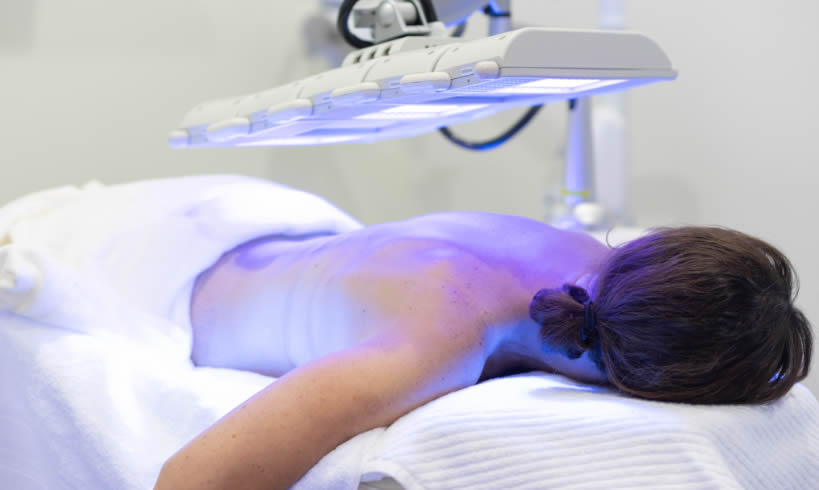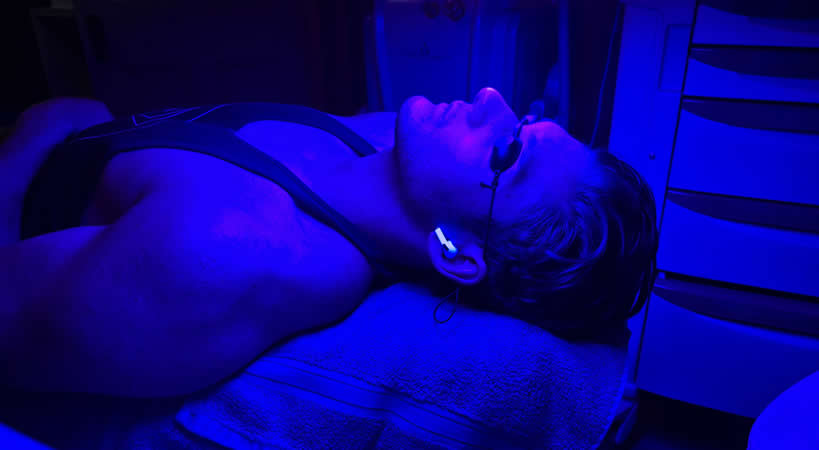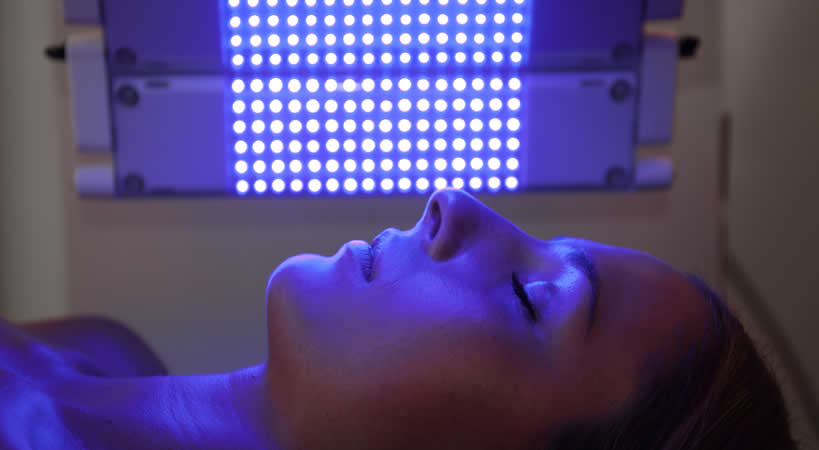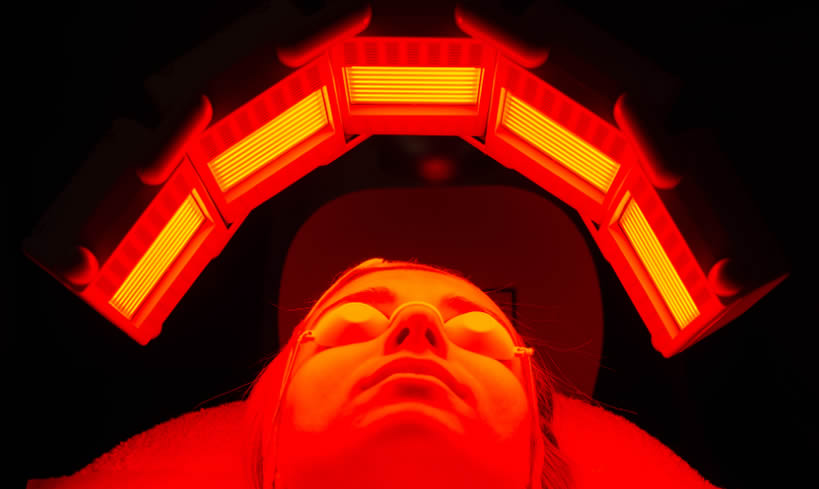LED Therapy
Medical Grade LED Therapy
So, what is LED Therapy? LED stands for Light Emitting Diode. Light or photo-radiation, the only form of energy we can see, is the source of all life on earth. This light interacts with cells and tissues of our body which translates into electrical signals, hormone signals and gene expression. It has been studied and tested across thousands of peer reviewed clinical trials, and the results are extremely positive across many applications.

The Xen LED used in our clinic is medical grade and made in Australia. It is used by professional athletes like the Manly Sea Eagles for its ability to improve performance, muscle recovery, tissue healing, as well as support mood and sleep. It uses three evidenced based clinically proven wavelengths in one array-medically optimised red, blue and near infrared wavelengths due to their ability to be preferentially absorbed by target cells and tissues for overall skin enhancement. The Xen LED uses 10,500 precisely aligned diodes, ensuring a zone of very high photon intensity to provide fast full dosage treatments. So what are the wavelengths and what do they do?
Blue 415nm wavelength
The blue wavelength, the shortest wavelength, reaches the outermost layer of the skin and is used to treat inflammatory skin conditions. The blue light interacts with the p. acnes bacteria to produce a photodynamic reaction that destroys the bacteria, reducing acne. It is also proven effective in reducing pore size and balancing sebum (oil) production.

Blue light treats:
- Acne by its antibacterial and anti-inflammatory properties.
- Reduces sebaceous hyperplasia (enlarged oil glands) which contribute to ongoing acne breakouts, whiteheads and blackheads.
- Psoriasis & Eczema by reducing inflammation and proliferation of skin cells.
- Reduces itching by reducing inflammation.
- Improves skin texture.
- Reduces actinic/solar keratosis (sunspots) and rough scaly precancerous spots.

Red 633nm wavelength
The red wavelength is a longer wavelength than the blue wavelength and penetrates deeper into the skin than the blue wavelength. It benefits ageing skin by accelerating cell renewal and repair by stimulating fibroblasts cells in the dermis to form collagen and elastin for smoother, firmer skin. It is clinically proven to increase the body’s natural form of cellular energy (ATP) which kickstarts cells to regenerate faster.

Red light treats:
- Wrinkles/fine lines by stimulating collagen and elastin.
- Redness and rosacea by reducing inflammation.
- Promotes hair growth by stimulating blood circulation in the scalp.
- Sleep by stimulating “fatigue’ hormones melatonin and adenosine.
- Improves mood/Seasonal Affective Disorder (SAD) by increasing levels of serotonin, a chemical in the brain that affects mood.
- Acne Scars by stimulating collagen and elastin.
- Reduces sebum (oil) production.
- Stimulates weight loss by reducing the size of fat cells.
- Psoriasis and eczema by reducing inflammation.
- Stretch marks by stimulating collagen.
- Repairs tissue by increasing the body’s natural form of cellular energy (ATP).
Near infrared (NIR) 830nm wavelength
The NIR wavelength is the longest out of the three wavelengths and has even more photo-bio stimulatory effects and is invisible to the naked eye. It penetrates the deepest out of the three wavelengths reaching right down to muscle and bone. It stimulates a photochemical reaction within cells that triggers collagen formation and systemic healing affects. The process increases blood flow and oxygenation while improving mitochondrial function, energy production, and cell regeneration.
NIR light treats:
- Detoxification and purification of cells.
- Relieves pain acute or chronic pain due to its anti-inflammatory effect.
- Reduces muscle tension and encourages relaxation.
- Weight loss by increasing metabolism in cells.
- Lowered side effects of diabetes such as diabetic neuropathy by increasing circulation and improving cellular oxygenation.
- Lowers blood glucose levels in diabetics.
- Boosts the immune system.
- Lowers blood pressure by relaxing blood vessels (vasodilation).

How long do LED treatments last?
Treatments times are approximately 30 minutes depending on skin type and condition treated.
Is LED treatment painful?
No, it is totally painless. Most people describe the treatment as feeling pleasantly warm.
Is there any preparation for the treatments?
No, there is no pretreatment preparation other than removing makeup and any topical creams on the skin before treatment.
How far apart are the sessions?
The treatments need to be at least 48 hours apart, so you can have up to three sessions per week.
How many sessions are required?
Six to eight sessions are required.
Are there any side effects of LED therapy?
Repeated exposure to LED can make the eyes very sensitive. Hence, eyes are protected with goggles and clients are asked to close their eyes during the treatment. People with a Fitzpatrick skin type 4 to 6 (moderately brown skin that doesn’t burn and tans well) may experience temporary bronzing which is normal and will subside within 48 hours.
Does it cause skin cancer?
No, there is no evidence that LED therapy causes skin cancer.
Who should not have light therapy?
Anyone suffering from the following conditions:
- Porphyria
- Epilepsy
- Autoimmune diseases stimulated by light e.g. lupus
- Congenital retinal disorders
- Solar urticaria
- Photophobia
- Taking photosensitising medication i.e. that make you burn more easily when out in the sun eg. lithium, phenothiazine, antipsychotics, roaccutane, isotretinoin, and certain antibiotics
- Pregnant or breast feeding or trying to conceive
- Diseases that affect the retina of the eye
- Had significant sun exposure or used a tanning bed in the last 4 weeks
- Used artificial tanning lotion in the plast 2 weeks
What is the difference between different at-home and medical grade LED machines?
One of the major issues we face with the specifications of LED within the aesthetic industry is that the majority of manufacturers refer to the power of their devices based on the input power consumption (like light globes) and not the resulting output therapeutic light intensities. With the Xen LED we specify the output light intensity. Xen LED uses 3rd generation Chip-On-Board (COB) technology to combine three wavelengths-415nm, 633nm and 830nm in 10,500 precisely aligned diodes, delivering high photon intensity and fast full dosage treatments in less time. With this large number of LEDs, Xen uses 3,500 LED’s for each of the three colours it delivers. In comparison, other well-known professional brand devices are only capable of utilising up to 1800 LEDs when using the less efficient SMD style of LEDs. Furthermore, many of the low-end home use systems run much less and are in the low 100’s. For liability reasons, most at-home LED devices are weak as they legally must carry very low to no risk of cumulative eye damage. This becomes obvious when you see that most smaller devices and face masks do not require a heat sink to dissipate heat, since they don’t produce high enough output to generate any heat. Low power means low quality results In most cases we see all of these manufacturers quote their intensities in regard to input power and not in relation to output therapeutic light, hence their output power is much lower than stated. Also, many at-home devices and clinics offer other colours (wavelengths) e.g. yellow, purple, green, however these colours don’t have enough clinical evidence behind them to justify their use. Consumers need to have realistic expectations about at-home LED devices and understand that most of these products will require very long term consistent use and likely only yield modest results.
